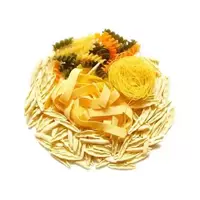Pasta

Pasta is no longer just a piece of dough that is kneaded with wheat flour and water. It is a symbol dish of several states and perhaps one of the most common foods throughout the land. The peoples of Italy and Sicily simply do not imagine their lives without pasta.
Historians have already established for certain that humanity began to grow wheat at the dawn of its existence. And interestingly, it was at that time that the first pasta was prepared, and completely randomly. Some of the ancient people kneaded dough from wheat flour and threw the remains in the sun, the dough dried. And ancient pasta is ready.
Currently, there are a huge number of varieties of pasta that differ in size, method of manufacture and preparation, taste, etc. Let's name only the most common classifications of pasta.
So there are dry pasta and raw pasta. The first pasta is thoroughly dried to store longer, and the second pasta after cooking is immediately eaten and not stored for a long time. In terms of size, you can distinguish: long pasta (spaghetti, noodles, fettuccine, bucatini, etc. ) - size 30 cm or more, short (spirals, feathers, ruote, farfalle), small pasta (usually used in soups, these are well-known stars).
There are very large pasta that is used to make cannelloni or lasagna. Pasta with a filling is also distinguished - these are famous ravioli or tortellini. Multi-colored pasta is made with all kinds of additives (herbs, vegetables, spices).
For example, a low calorie content of pasta from coarse flour has long been noted, such products have a gray-brown color and are often used in dietary nutrition. Pizzokerri is a pasta made from wheat and buckwheat flour, and glass noodles are considered a famous Asian pasta. This variety of pasta species opens up wide expanses for culinary experimentation.
The benefits of pasta
Now let's talk about how great the benefits of pasta are, and maybe the harm. Let's take a look at the composition of macorones: about 75% of carbohydrates, as well as proteins and lipids. The great benefit of pasta is the amount of carbohydrates that they saturate our bodies, and carbohydrates are energy.
The calorie content of pasta certainly depends on the type of product, but on average is 338 Kcal per 100 grams. Many mistakenly claim that the harm of pasta to a good figure is obvious - high calorie content. This is fundamentally not a true statement.
The harms of pasta
It is worth clarifying that this is the calorie content of dry pasta, but we cook them before eating them. The calorie content of cooked pasta is significantly lower, so they are included in dietary nutrition. True, we are used to eating not just cooked pasta, but with something, for example, meat, chicken or goulash. So, so that pasta becomes a dietary diet, it is better to cook them with vegetable sauces. Without adding even more calorie (fat-containing) ingredients to the dishes, you can be sure that there will simply be no harm from pasta with vegetables for your figure.
pasta 338 kCal
Energy value of pasta (Ratio of proteins, fats, carbohydrates - ju):
Proteins: 11 g (~ 44 kCal)
Fats: 1.3 g (~ 12 kCal)
Carbohydrates: 70.5 g (~ 282 kCal)
Energy ratio (bj | y): 13% | 3% | 83%
 Español
Español Français
Français Português
Português Русский
Русский 简体中文
简体中文 繁體中文
繁體中文 日本語
日本語 한국어
한국어 العربية
العربية Türkçe
Türkçe Қазақ
Қазақ Deutsch
Deutsch Italiano
Italiano Українська
Українська
